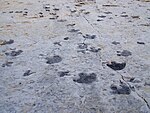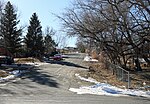Dinosaur Ridge is a segment of the Dakota Hogback in the Morrison Fossil Area National Natural Landmark located in Jefferson County, Colorado, near the town of Morrison and just west of Denver.
The Dinosaur Ridge area is one of the world's most famous dinosaur fossil localities. In 1877, fossil excavation began at Dinosaur Ridge under the direction of paleontologist Othniel Charles Marsh. Some of the best-known dinosaurs were found here, including Stegosaurus, Apatosaurus, Diplodocus, and Allosaurus. In 1973, the area was recognized for its uniqueness as well as its historical and scientific significance when it was designated the Morrison Fossil Area National Natural Landmark by the National Park Service. In 1989, the Friends of Dinosaur Ridge formed to address increasing concerns regarding the preservation of the site and to offer educational programs on the area's resources.
The rocks on the west side of Dinosaur Ridge are part of the widespread Morrison Formation of Jurassic age. It is in these rocks, where Arthur Lakes discovered the dinosaur bones in 1877. Fifteen quarries were opened along the Dakota hogback in the Morrison area in search of these fossils.
The rocks on the east side of Dinosaur Ridge are part of the Cretaceous Dakota Formation. When Alameda Parkway was being constructed in 1937 to provide access to Red Rocks Park, workers discovered hundreds of dinosaur footprints. These were found to include mostly Iguanodon-like footprints, perhaps from Eolambia. Carnivorous theropod tracks are also present.
The site features the Dinosaur Ridge Exhibit Hall with displays about the dinosaurs found at the site. Additionally, Dinosaur Ridge has interpretive signs at trail locations that explain the local geology, a volcanic ash bed, trace fossils, paleo-ecology, economic development of coal, oil and clay, and many other geologic and paleontological features.
In June 2011, Dinosaur Ridge was combined with another track site, the Parfet Prehistoric Preserve, about three miles north. The combined National Natural Landmark is now the Morrisson-Golden Fossil Areas.









